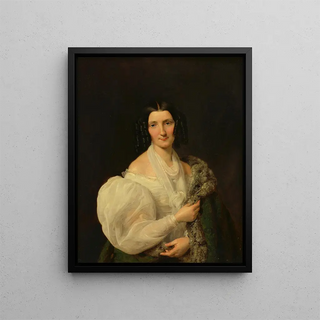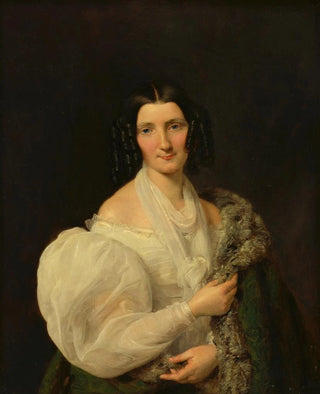Painting Barbara von Schickh as the wife of Wolfgang Ritter von Manner - Ferdinand Georg Waldmüller


View from behind

Frame (optional)
Reproduction Barbara von Schickh comme épouse de Wolfgang Ritter von Manner - Ferdinand Georg Waldmüller – Captivating introduction
In the vast panorama of art history, some works manage to capture the very essence of their era while transcending the limits of time. The art print Barbara von Schickh as the wife of Wolfgang Ritter von Manner, created by Ferdinand Georg Waldmüller, stands out for its ability to evoke deep intimacy and timeless beauty. This painting, which depicts Wolfgang Ritter's wife, embodies not only a portrait but also a rich visual narrative full of emotions and meanings. Through this masterpiece, Waldmüller invites us to immerse ourselves in a world where everyday life blends with art, where every detail matters, and where the lives of the subjects are highlighted with remarkable finesse.
Style and uniqueness of the work
Waldmüller's style is often characterized by striking realism, and this work is no exception. The composition exudes an atmosphere of serenity and elegance, where the figure of Barbara von Schickh stands with natural grace. Carefully chosen colors, ranging from soft shades to deeper nuances, help create a warm and welcoming ambiance. The artist excels in depicting textures, fabrics, and clothing details, making each element tangible. The play of light and shadow adds an extra dimension to the scene, emphasizing the delicate features of Barbara's face while highlighting her posture. Waldmüller thus manages to capture not only her physical appearance but also the essence of her personality, making the portrait lively and engaging.
The artist and his influence
Ferdinand Georg Waldmüller is an emblematic figure of the 19th century, whose work has profoundly shaped the Austrian artistic landscape. Influenced by the Romantic movement, he combined a realistic approach with poetic sensitivity, creating works that speak to the soul. His portraits, often imbued with palpable intimacy, testify to his ability to establish an emotional connection with his subjects. Waldmüller also played a crucial role in the evolution of genre painting, highlighting scenes of everyday life with a simultaneously critical and

Matte finish

View from behind

Frame (optional)
Reproduction Barbara von Schickh comme épouse de Wolfgang Ritter von Manner - Ferdinand Georg Waldmüller – Captivating introduction
In the vast panorama of art history, some works manage to capture the very essence of their era while transcending the limits of time. The art print Barbara von Schickh as the wife of Wolfgang Ritter von Manner, created by Ferdinand Georg Waldmüller, stands out for its ability to evoke deep intimacy and timeless beauty. This painting, which depicts Wolfgang Ritter's wife, embodies not only a portrait but also a rich visual narrative full of emotions and meanings. Through this masterpiece, Waldmüller invites us to immerse ourselves in a world where everyday life blends with art, where every detail matters, and where the lives of the subjects are highlighted with remarkable finesse.
Style and uniqueness of the work
Waldmüller's style is often characterized by striking realism, and this work is no exception. The composition exudes an atmosphere of serenity and elegance, where the figure of Barbara von Schickh stands with natural grace. Carefully chosen colors, ranging from soft shades to deeper nuances, help create a warm and welcoming ambiance. The artist excels in depicting textures, fabrics, and clothing details, making each element tangible. The play of light and shadow adds an extra dimension to the scene, emphasizing the delicate features of Barbara's face while highlighting her posture. Waldmüller thus manages to capture not only her physical appearance but also the essence of her personality, making the portrait lively and engaging.
The artist and his influence
Ferdinand Georg Waldmüller is an emblematic figure of the 19th century, whose work has profoundly shaped the Austrian artistic landscape. Influenced by the Romantic movement, he combined a realistic approach with poetic sensitivity, creating works that speak to the soul. His portraits, often imbued with palpable intimacy, testify to his ability to establish an emotional connection with his subjects. Waldmüller also played a crucial role in the evolution of genre painting, highlighting scenes of everyday life with a simultaneously critical and
12,34 €






